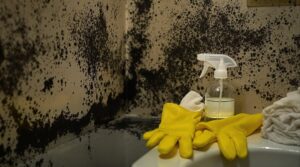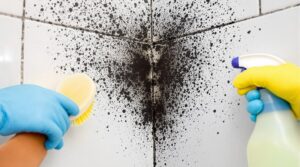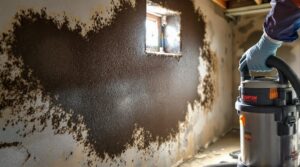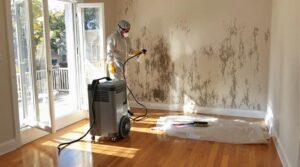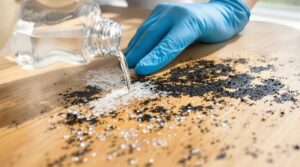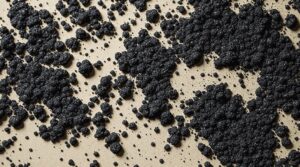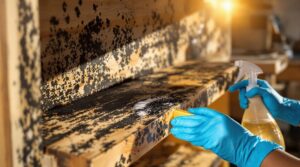Living in a house with black mold is not recommended due to serious health risks. Exposure can cause respiratory issues, allergic reactions, and long-term cognitive problems. Immediate evacuation is necessary if contamination exceeds 10 square feet or if spore levels surpass 75,000. Small affected areas under 10 square feet may allow continued occupancy with proper containment and remediation. Professional assessment helps determine safe occupancy thresholds and necessary protective measures.
Key Takeaways
- Evacuate immediately if mold contamination exceeds 10 square feet or if spore count surpasses 75,000.
- Short-term exposure can cause respiratory issues, allergic reactions, coughing, and sneezing.
- Long-term exposure leads to serious health problems including memory issues and chronic fatigue.
- Small areas under 10 square feet can be safe with proper containment and if located only on non-porous surfaces.
- Professional assessment is required to determine toxicity levels and whether the home remains safe for occupancy.
Understanding the Risks of Black Mold Exposure
The prevalence of black mold in residential spaces poses substantial health risks that require thorough examination. Exposure patterns vary based on spore distribution throughout the home, with health effects ranging from mild allergic reactions to severe systemic illnesses. The impact of black mold exposure is particularly concerning for individuals with compromised immune systems or pre-existing respiratory conditions.
The severity of health complications depends on multiple factors, including duration of exposure, concentration of mycotoxins, and individual susceptibility. Extended contact with black mold can trigger chronic inflammatory response syndrome (CIRS), affecting multiple organ systems.
When evaluating potential health impacts, it's vital to examine that even contained mold infestations can release airborne spores, potentially causing widespread contamination throughout living spaces. Genetic predisposition and overall health status markedly influence an individual's vulnerability to mold-related illness. Initial exposure to mold often manifests as respiratory and cognitive symptoms that may improve when leaving the affected environment.
Signs and Symptoms of Black Mold in Your Home
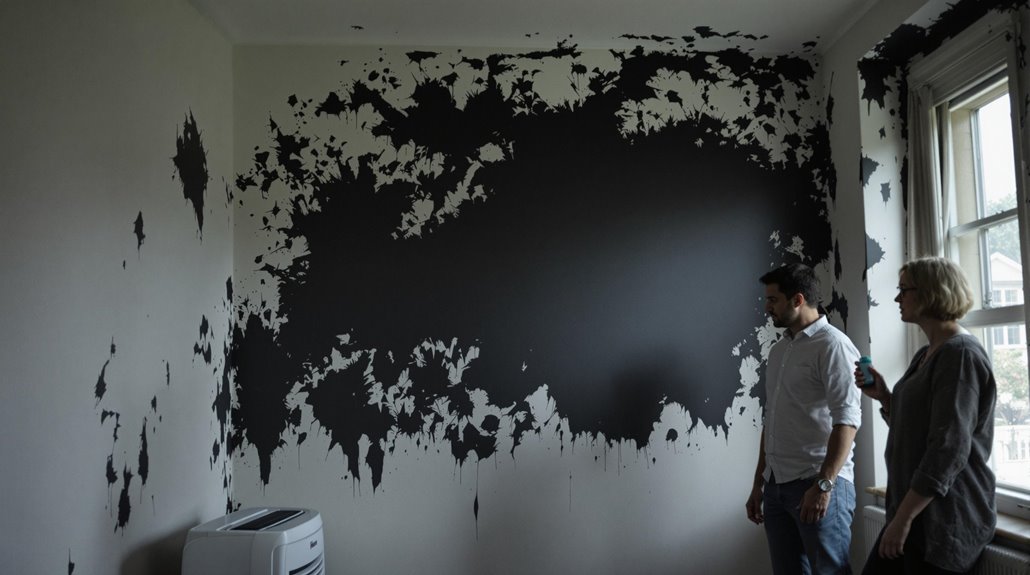
Black mold manifests through visible dark patches that can expand across walls, ceilings, and other surfaces, often accompanied by surface deterioration like peeling paint or warped materials.
A persistent musty odor, particularly in areas prone to moisture, serves as a key indicator of hidden mold growth within the home.
Residents may experience characteristic health reactions while inside the affected space, including respiratory issues, allergic responses, and headaches, which often improve when away from the contaminated environment.
The presence of relative humidity levels above 70% creates ideal conditions for black mold to thrive and spread throughout your home.
Visible Mold Growth Patterns
Identifying visible signs of toxic mold growth requires understanding distinct patterns and characteristics that set it apart from other household fungi.
Black mold manifests as dark green or black patches with irregular, circular spread patterns across surfaces. These expanding patches often display fuzzy edges due to active spore production, and when left untreated, they merge to cover larger areas.
The mold's texture varies depending on its growth stage, appearing slimy or wet during active growth periods and becoming powdery when dry.
Common growth locations include bathrooms, kitchens, basements, and attics where moisture and poor ventilation create ideal conditions. The presence of dark spots with a slightly greenish tint, particularly in areas with high cellulose content, strongly indicates black mold infestation.
Under optimal conditions of high indoor humidity and temperatures between 77-86°F, black mold can begin developing within just 24-48 hours of water exposure.
Musty Odors Reveal Presence
Beyond visible indicators, a persistent musty odor serves as a telltale warning sign of black mold infestation within homes.
Through smell detection techniques, occupants can identify potential mold growth even when hidden behind walls or under surfaces. The intensity of these odors typically increases with humidity levels and poor ventilation, making bathrooms, basements, and poorly ventilated areas primary locations for odor mapping.
- Mature black mold colonies emit stronger, more pungent odors compared to younger growths
- The smell becomes more concentrated in enclosed spaces with limited air circulation
- Different surface materials can affect the characteristic musty scent
- High moisture levels intensify the odor, making detection more pronounced during humid conditions
Professional assessment remains essential for confirming the presence and extent of black mold, as odors alone cannot definitively identify specific mold species.
Proper moisture meter testing can help identify high-risk areas where mold may be actively growing before visible signs appear.
Health Reactions at Home
Living in a home with black mold exposure can trigger numerous adverse health reactions, ranging from mild allergic responses to severe respiratory complications. Common immune responses include persistent coughing, sneezing, and eye irritation, which can be mistaken for seasonal allergies.
However, respiratory symptoms often worsen with continued exposure, potentially leading to asthma attacks and breathing difficulties.
Certain individuals face heightened risks, particularly those with compromised immune systems, pre-existing respiratory conditions, the elderly, young children, and pregnant women.
Long-term exposure may result in chronic health issues, including persistent fatigue, memory problems, and lung disease. For vulnerable populations, even brief exposure to black mold can trigger serious health complications, necessitating immediate attention to any signs of mold presence in the home. The presence of musty odors and discoloration are early warning signs that indicate dangerous mold growth in your living space.
Health Effects of Living With Black Mold
Prolonged exposure to black mold presents severe health risks that can affect multiple body systems and lead to chronic illnesses. Individuals with respiratory conditions, allergies, or compromised immune systems may experience exacerbated symptoms, including persistent coughing, sneezing, and skin irritations. To mitigate these health hazards, it is crucial to implement black mold cleaning safety tips that emphasize proper ventilation and the use of protective gear during removal. Additionally, addressing any sources of moisture and ensuring thorough cleaning can prevent future infestations and safeguard overall well-being.
The health impacts range from immediate allergic reactions to long-term immunological effects, particularly in vulnerable populations such as infants, elderly, and those with compromised immune systems.
Living with black mold can trigger:
- Respiratory diseases including hypersensitivity pneumonitis, acute neutrophilic rhinitis, and severe asthma attacks
- Chronic inflammatory response syndrome (CIRS) affecting neurological and digestive functions
- Systemic symptoms like brain fog, circulation issues, and peripheral neuropathy
- Persistent sinus infections that may continue even after leaving the contaminated environment
These conditions can progressively worsen over time, potentially leading to severe complications and chronic health issues that affect quality of life and overall well-being.
When indoor spore levels exceed 75,000 spores, immediate evacuation of the premises is necessary to prevent severe health complications.
Immediate Steps to Take When Black Mold Is Found
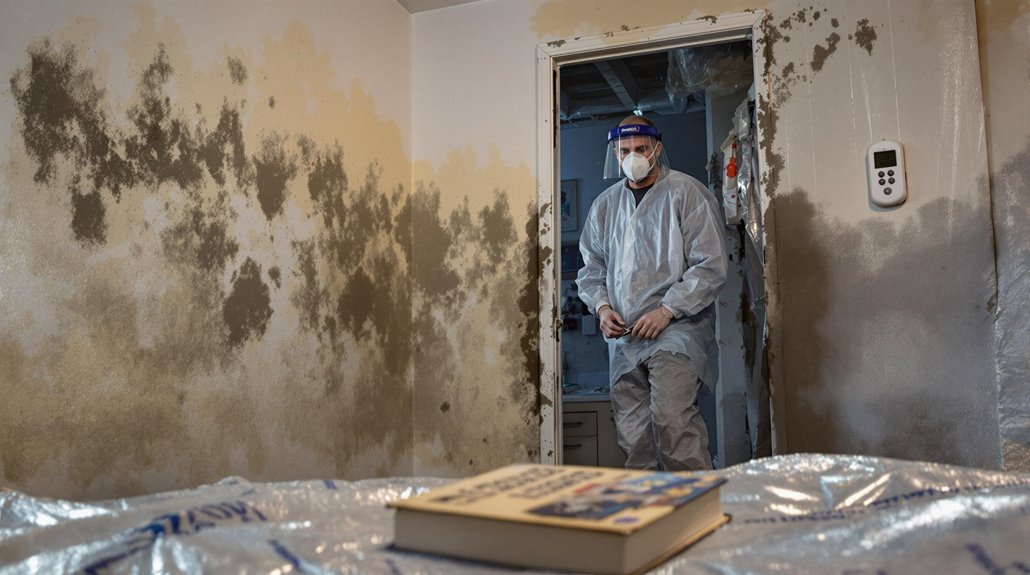
Upon discovering black mold in a home, immediate and systematic action must be taken to protect occupants' health and prevent further contamination. Initial steps include shutting down HVAC systems to prevent spore circulation and implementing protective sealing of affected areas. Depending on the infestation's severity, quick evacuation may be necessary while remediation plans are developed. Areas larger than 10 square feet contaminated typically require temporary relocation of all residents during the remediation process.
| Critical Actions | Safety Measures | Professional Support |
|---|---|---|
| Stop water leaks | Wear PPE gear | Contact specialists |
| Isolate areas | Seal off vents | Request testing |
| Turn off HVAC | Remove wet items | Document damage |
Once these immediate measures are implemented, professional assessment becomes essential for determining the full extent of contamination and developing a thorough remediation strategy. Proper documentation of visible mold and moisture damage will assist in planning the cleanup process and addressing any insurance claims.
Safe Cleanup and Remediation Methods
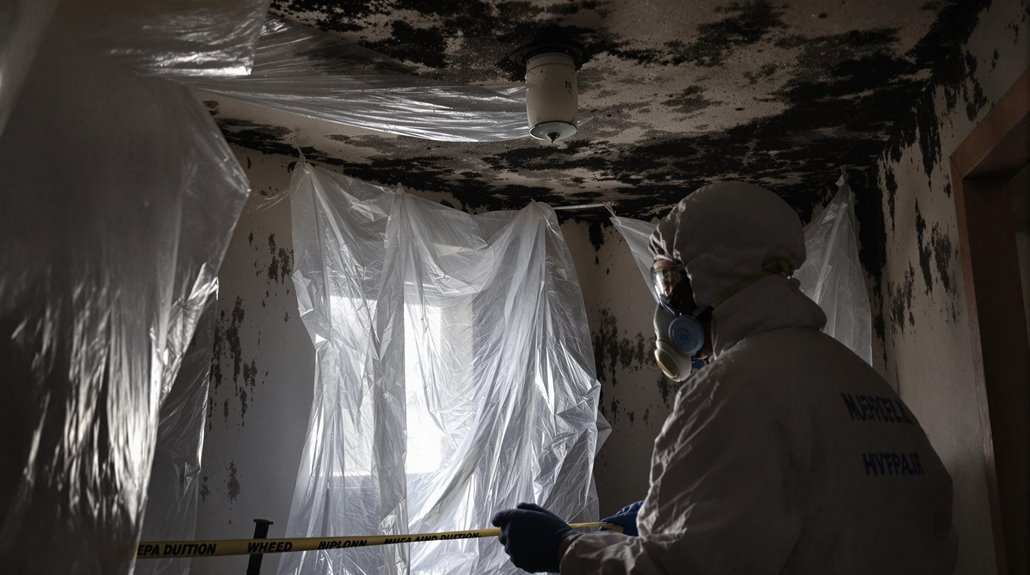
While small areas of mold (under 10 square feet) can potentially be handled through careful DIY methods, extensive black mold contamination requires professional remediation services due to the complexities of proper containment and removal.
Safe DIY cleanup necessitates specific protective equipment, including N-95 respirators, gloves, and goggles, along with proper containment procedures using plastic sheeting and ventilation controls.
Professional remediation teams possess specialized equipment such as HEPA air filtration systems and EPA-approved biocides, ensuring thorough containment and elimination of black mold while minimizing health risks to occupants.
Areas with relative humidity above 60% create ideal conditions for rapid mold growth and colonization.
DIY Versus Professional Cleanup
Making informed decisions about mold cleanup requires careful consideration of the scope, type, and location of the infestation.
While homeowners can address small areas under 10 square feet on non-porous surfaces, professional intervention becomes essential for toxic varieties like black mold or large-scale contaminations.
Renovation tips for DIY cleanup include using natural solutions and proper containment basics to prevent spore spread.
- Areas under 10 square feet on non-porous surfaces are suitable for DIY remediation
- Professional cleanup is mandatory for toxic mold types and areas exceeding 10 square feet
- Complex locations, such as HVAC systems or hidden spaces, require specialized expertise
- Homes with vulnerable occupants, including children or immunocompromised individuals, should always employ professional remediation services
Proper safety measures require wearing N-95 respirator masks and protective equipment during any mold remediation work.
Essential Safety Equipment Required
Safe mold cleanup requires specific protective equipment and specialized tools to minimize health risks during remediation. The essential safety equipment includes non-vented goggles, long rubber gloves, full-body disposable coveralls, and respirators with particulate filters that provide 99.97% protection from airborne mold spores.
Protection protocols mandate the use of air scrubbers with HEPA filters, negative air machines, and dehumidifiers to control contamination.
Professional-grade tools such as moisture meters, laser particle counters, and sprayers are necessary for effective remediation.
Proper containment requires zipwall dust barrier kits to prevent spore spread throughout the building. All safety equipment must work in conjunction with established containment procedures to guarantee thorough mold removal while protecting both occupants and remediation workers from exposure.
Indoor spaces should maintain 30-50% humidity levels to prevent future mold growth after remediation is complete.
Prevention and Long-Term Solutions
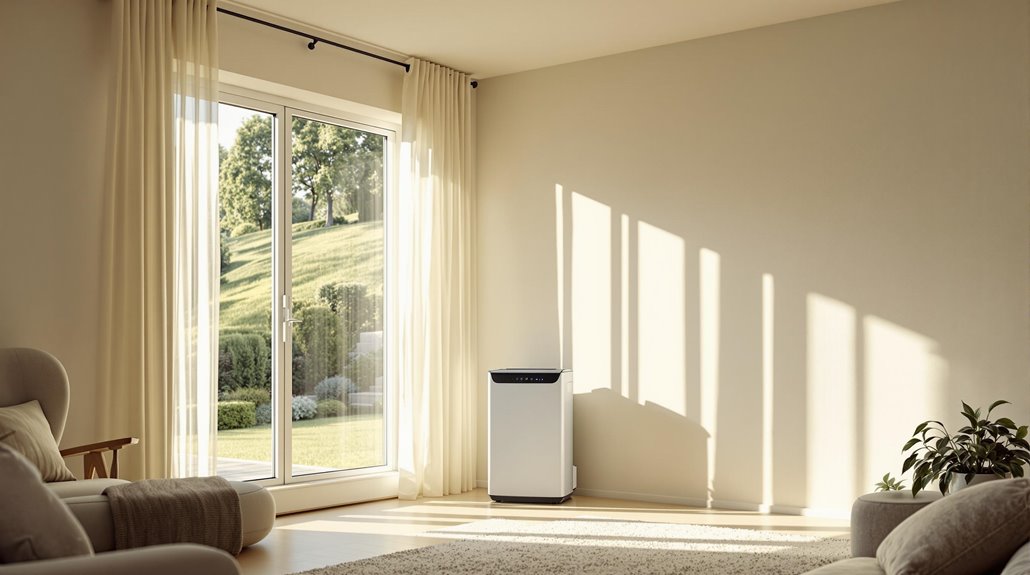
Preventing black mold growth requires a thorough approach that combines moisture control, proper ventilation, and regular maintenance.
Effective moisture control strategies include maintaining humidity levels below 60-65% and promptly addressing water leaks. Installing proper ventilation systems guarantees adequate air circulation while reducing condensation buildup.
Long-term prevention also involves using mold-resistant materials during renovations and implementing strategic landscaping techniques.
- Monitor humidity levels consistently and use dehumidifiers in moisture-prone areas
- Install whole-house ventilation systems with proper filtration capabilities
- Apply mold-resistant paints and materials during home improvements
- Grade landscape away from home foundations to prevent water accumulation
These preventive measures, combined with regular inspections and maintenance, create an environment less conducive to mold growth while protecting both the structure and its occupants.
When to Contact Professional Help
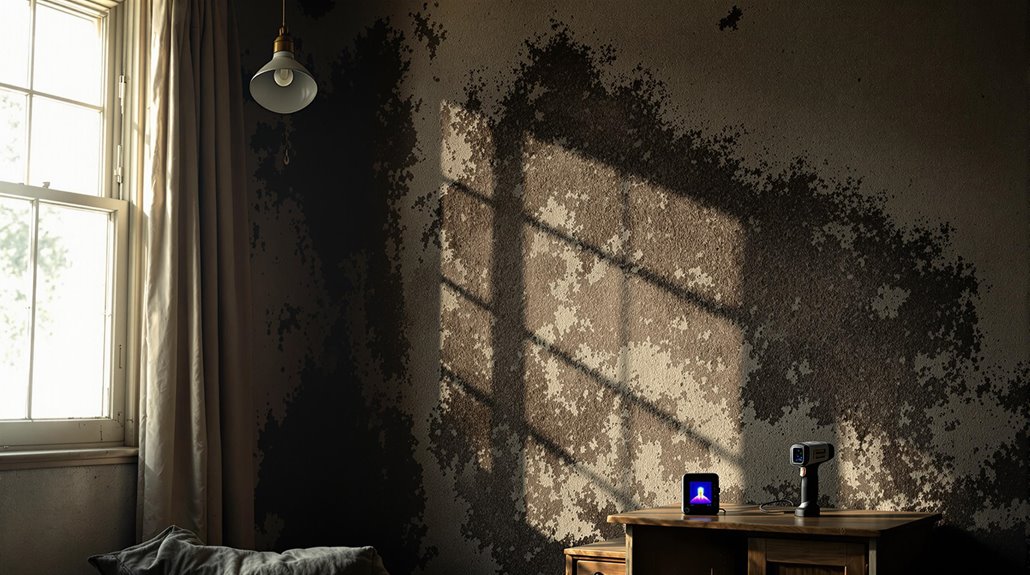
Recognizing the right time to contact professional mold remediation services is essential for both personal safety and effective mold removal. Homeowners should seek professionals with proper credentials when mold coverage exceeds 10 square feet, or when visible growth appears in frequently occupied spaces like bedrooms and living areas.
Immediate response timeframes are vital when residents experience unexplained health symptoms such as persistent coughing or eye irritation. Professional intervention becomes necessary following water damage incidents or when strong musty odors persist without visible sources.
Experts employ specialized equipment including thermal imaging cameras and conduct thorough testing through surface, air, and bulk sampling methods. Laboratory analysis identifies specific mold types and concentrations, enabling targeted remediation strategies that prevent future growth while ensuring thorough restoration of affected areas.
Protecting Vulnerable Family Members From Mold Exposure
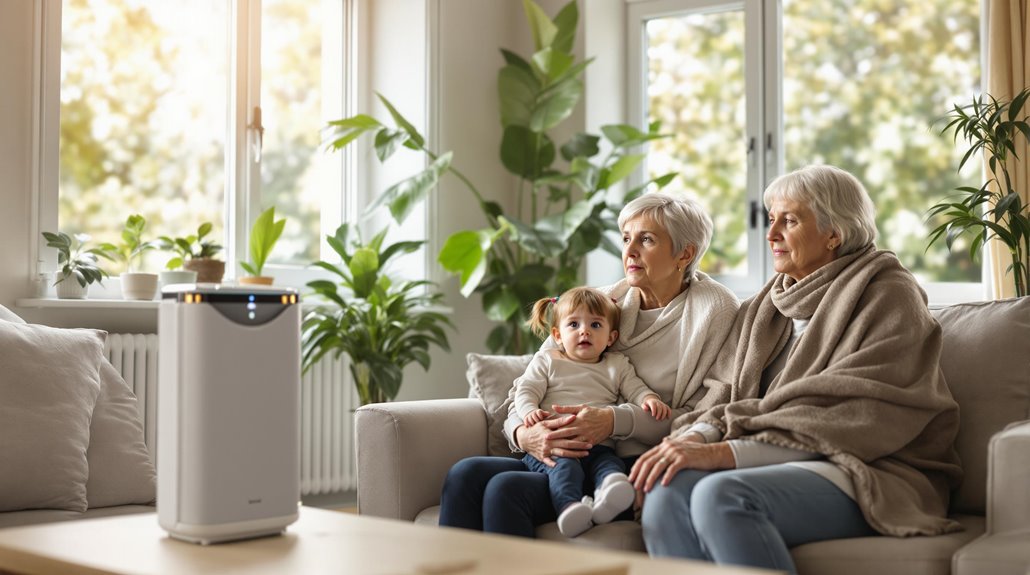
While professional remediation addresses the physical removal of mold, protecting high-risk family members requires specific preventive measures and heightened vigilance.
Children and elderly individuals face heightened risks due to their compromised or developing immune systems, making vulnerable protection essential during mold exposure.
Elderly safety becomes particularly critical as existing conditions like COPD or heart disease can worsen substantially when exposed to mold spores.
- Relocate vulnerable family members to mold-free environments until complete remediation
- Install high-efficiency air filtration systems in rooms frequently occupied by at-risk individuals
- Monitor symptoms closely and seek immediate medical attention if respiratory issues develop
- Create designated "clean rooms" with controlled humidity and enhanced ventilation for sensitive family members
The Benefits Of Consulting A Public Adjuster
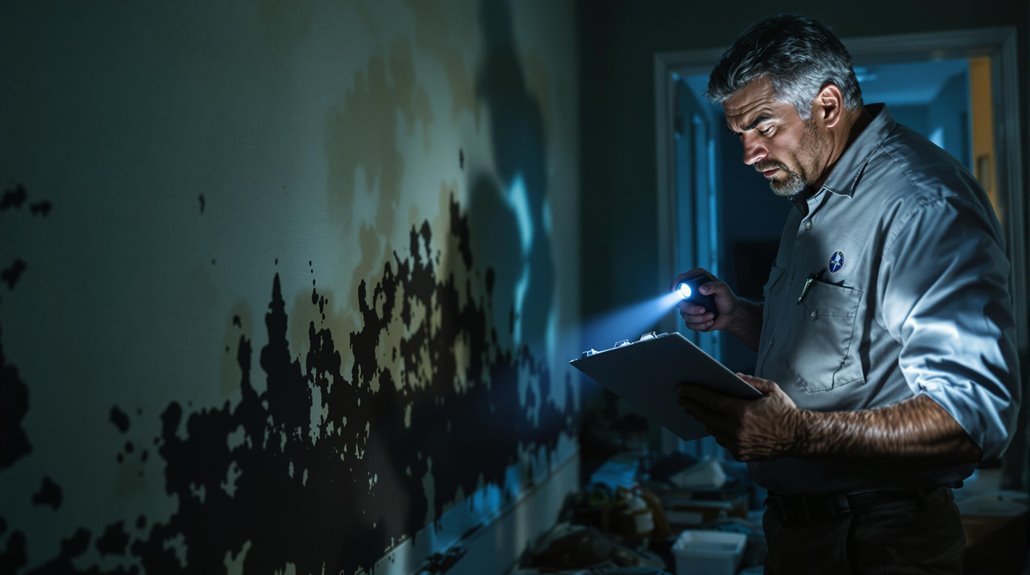
When dealing with black mold insurance claims, consulting a public adjuster provides critical expertise in documenting damage, interpreting policies, and maximizing settlement outcomes.
Public adjusters offer objective assessments of mold-related damages while managing all aspects of the claims process, from initial documentation to final negotiations with insurance companies.
Their contingency-based services typically result in higher claim payouts by ensuring all damages are properly identified and valued, including hidden structural issues that could be overlooked in standard assessments.
Expertise In Insurance Claims
Public adjusters bring essential expertise to black mold insurance claims through their thorough understanding of policies and procedures. Their knowledge encompasses coverage limits, exclusions, and effective claim strategies that maximize settlement outcomes.
These professionals interpret complex policy language and guarantee all entitled benefits are properly addressed during the claims process.
- Evaluate policy coverage and exclusions specific to mold damage
- Document all evidence thoroughly with photos, videos, and professional assessments
- Navigate insurance company tactics that might minimize claim settlements
- Present exhaustive claims packages that address all damaged areas
Their expertise proves particularly valuable when dealing with mold-related claims, as these often involve complex documentation requirements and specific coverage limitations.
Public adjusters work exclusively for policyholders, providing objective advocacy throughout the claims process while maintaining professional detachment for maximum results.
Objective Damage Assessment
A thorough damage assessment conducted by qualified public adjusters provides homeowners with an unbiased evaluation of their mold-related property damage. Through exhaustive Environmental Testing and standardized Assessment Protocol, public adjusters meticulously document the extent of mold growth, identify hidden damage, and determine underlying causes such as water intrusion or plumbing failures.
These professionals conduct detailed inspections that go beyond surface-level observations, examining concealed spaces where mold may proliferate.
Their systematic approach includes gathering photographic evidence, preparing detailed documentation, and developing exhaustive repair estimates. This objective assessment serves as vital documentation for insurance claims, ensuring that all aspects of mold-related damage are properly identified and accounted for in the settlement process. The resulting reports provide a reliable foundation for negotiations with insurance companies.
Streamlined Claim Process
Engaging a public adjuster substantially streamlines the insurance claims process for homeowners dealing with black mold damage. These professionals expedite settlements through efficient documentation management, coordinated inspections, and expert policy interpretation.
Their involvement facilitates rapid resolution by handling all communications with insurance companies while traversing complex regulatory requirements.
- Documentation and evidence collection are systematically organized, ensuring thorough damage assessment
- Direct negotiations with insurance providers reduce bureaucratic delays and expedite claim processing
- Expert policy interpretation prevents common filing errors that could delay settlement
- Professional management of the entire claims process allows homeowners to focus on health and safety concerns
Public adjusters provide the technical expertise and dedicated attention necessary to transform a potentially lengthy claims process into an efficiently managed procedure, ultimately achieving faster claim resolution for mold-affected properties.
Higher Claim Payouts & Settlements
Beyond streamlining the claims process, consulting a public adjuster often results in substantially higher settlement amounts for black mold damage claims. Through thorough claim assessment and skilled settlement negotiation, public adjusters maximize compensation by identifying all damages and guaranteeing proper valuation.
| Benefit | Impact on Settlement |
|---|---|
| Expert Assessment | Identifies hidden mold damage |
| Policy Knowledge | Ensures all covered benefits |
| Negotiation Skills | Counters insurance tactics |
| Documentation | Strengthens claim evidence |
| Industry Expertise | Maximizes claim value |
Their expertise in policy interpretation and understanding of insurance company tactics enables them to advocate effectively for policyholders. Public adjusters' specialized knowledge in property damage assessment, particularly in cases involving black mold, helps guarantee that all aspects of contamination and resulting damages are properly documented and valued in the final settlement.
About The Public Claims Adjusters Network (PCAN)
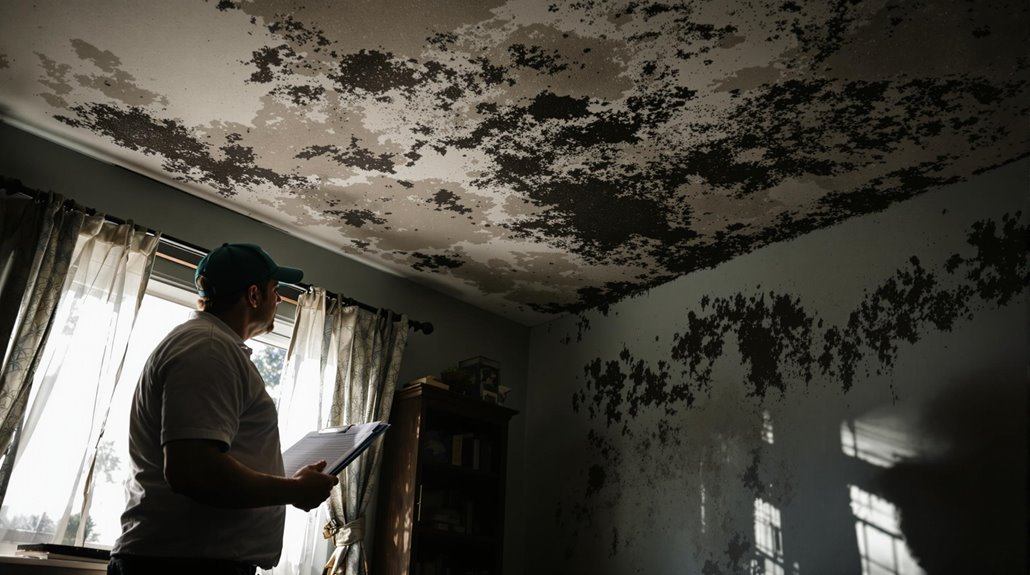
The Public Claims Adjusters Network (PCAN) operates as a professional coalition of independent insurance claims specialists who provide complete support throughout the claims process.
Through established professional partnerships, their adjuster network delivers thorough solutions from initial loss notification to final settlement, incorporating both routine and catastrophic claims management services.
Key aspects of PCAN's service framework include:
- Licensed adjusters operating under strict state regulations and compliance standards
- Customized claim handling solutions tailored to each client's unique circumstances
- Expert support through dedicated call centers and field operations
- Performance-based compensation structure ranging from 2% to 25% of claim proceeds
PCAN maintains high professional standards while exclusively representing the insured's interests, ensuring thorough documentation and presentation of claims for maximum settlement outcomes.
Frequently Asked Questions
How Long Does It Take for Black Mold to Grow After Water Damage?
Unwanted fungal visitors can emerge rapidly after water exposure. The moisture timeline indicates black mold growth duration typically begins within 24-48 hours, with visible colonies developing in 1-2 days.
Can My Pets Get Sick From Black Mold Exposure?
Black mold exposure can cause serious health issues in pets, triggering various pet symptoms including respiratory distress, skin irritations, and animal allergies. Immediate veterinary attention is essential when exposure occurs.
Does Homeowner's Insurance Typically Cover Black Mold Removal?
Like traversing a complex maze, homeowner's insurance coverage for black mold varies. Insurance claims are typically covered only when resulting from sudden, documented water damage, with numerous coverage exclusions for maintenance-related issues.
Will Painting Over Black Mold Stop It From Spreading?
Painting over black mold proves ineffective at preventing spread, as chemical reactions continue beneath the surface. The mold remains active, growing through paint layers while maintaining its biological processes.
Can Black Mold Return After Professional Remediation?
Despite professional remediation effectiveness, black mold can aggressively return if underlying moisture issues persist. Regular preventive maintenance, humidity control, and addressing structural problems are essential for long-term success.
References
- https://www.healthline.com/health/black-mold-exposure
- https://moldremediation.io/can-i-stay-in-my-house-with-black-mold/
- https://atirestoration.com/blog/toxic-black-mold-vs-black-mold/
- https://heartlandinspections.com/can-i-stay-in-my-house-with-black-mold/
- https://www.medicalnewstoday.com/articles/323419
- https://www.airoasis.com/blogs/articles/health-effects-black-mold-stachybotrys-chartarum
- https://www.alldryus.com/blog/mold/is-it-dangerous-to-live-in-house-with-black-mold/
- https://www.webmd.com/lung/can-black-mold-kill-you
- https://www.gpinspect.com/article/black-mold-exposure-symptoms/
- https://realtimelab.com/black-mold/
